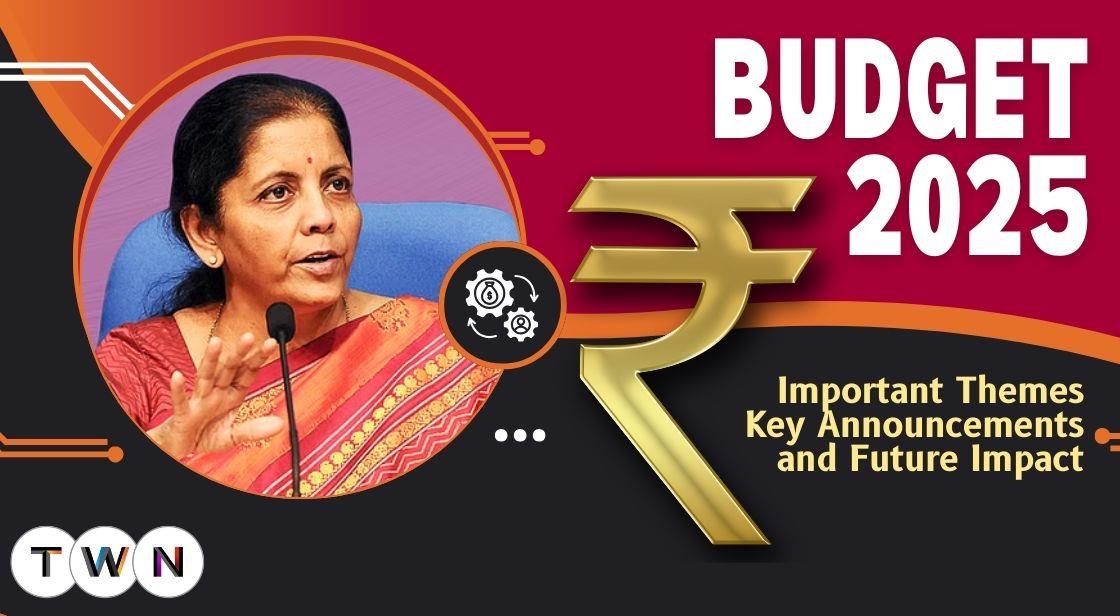India Budget 2025 Unveiled – Important Themes, Key Announcements, and Future Impact

Blog Post
The Union Budget 2025, presented by Finance Minister Nirmala Sitharaman on February 1, lays out a transformative vision for India’s economic growth and development.
Marking her eighth consecutive budget, Sitharaman introduced key reforms across multiple sectors, emphasizing inclusivity, sustainability, and long-term economic resilience.
With a strategic focus on taxation, urban development, financial services, power, and regulatory frameworks, the budget aims to drive investments, strengthen domestic industries, and enhance ease of doing business.
This budget sets the stage for India’s next phase of growth under the vision of "Sabka Vikas," prioritizing four key groups: the underprivileged (Garib), youth (Yuva), farmers (Annadata), and women (Nari).
Key highlights include tax relief for individuals, enhanced support for MSMEs and startups, infrastructure expansion, employment generation, and significant investments in education, healthcare, and innovation.
With ambitious fiscal targets and forward-looking policies, Budget 2025 outlines a roadmap to accelerate India's economic trajectory while ensuring social welfare and sustainability.
This article delves into the major announcements, sector-wise allocations, and the expected impact of these measures on businesses, individuals, and the overall economy.
India Budget 2025 Explained – Major Takeaways, Key Details, and Possible Effects
Nirmala Sitharaman Budget 2025 Speech
Finance Minister Nirmala Sitharaman made history on Saturday by delivering her eighth consecutive budget speech, which lasted 74 minutes. With this, she moves closer to the record held by former Prime Minister Morarji Desai, who presented a total of 10 budgets across different periods. Desai delivered six budgets as Finance Minister between 1959 and 1964, followed by four more between 1967 and 1969.
Finance Minister Nirmala Sitharaman presented the Union Budget 2025 on February 1, unveiling transformative reforms across six key sectors: taxation, urban development, mining, financial services, power, and regulatory frameworks. The budget aims to accelerate economic growth, with a strong focus on inclusivity and sustainability.
The government envisions the next five years as a critical period for achieving "Sabka Vikas," fostering development in all regions. The budget highlights a strategic focus on four key groups: the underprivileged (Garib), youth (Yuva), farmers (Annadata), and women (Nari).
Major Focus Areas of Budget 2025
-
Boosting Agricultural Growth and Productivity
-
Strengthening Rural Economy and Livelihoods
-
Promoting Inclusive Growth for All
-
Advancing Manufacturing and Make in India
-
Supporting Micro, Small, and Medium Enterprises (MSMEs)
-
Enabling Employment-Driven Development
-
Investing in People, Economy, and Innovation
-
Ensuring Energy Security and Sustainability
-
Expanding Export Capabilities
-
Fostering Research and Innovation
Budget 2025 Sector-Wise Key Announcements
Agriculture and Rural Development
-
The first phase of the agricultural development plan will cover 100 districts.
-
A six-year mission for self-reliance in pulses, with a special focus on toor and masoor dal.
-
Comprehensive initiatives for fruit and vegetable farming to ensure efficient supply chains and better pricing for farmers.
-
A new Makhana Board is to be established in Bihar for enhanced production, processing, and marketing.
-
A National Mission on High-Yielding Seeds to enhance agricultural productivity.
-
Sustainable fisheries development, with a special focus on Andaman & Nicobar and Lakshadweep.
-
Cotton productivity mission for five years to ensure a steady supply of high-quality cotton.
-
Loan limits under the Kisan Credit Scheme increased from Rs 3 lakh to Rs 5 lakh.
-
India Post to be transformed into a large-scale logistics organization.
Fiscal and Economic Projections
-
Fiscal deficit target for FY25 set at 4.8%, and 4.4% for FY26.
-
Revised capital expenditure (Capex) for FY25 projected at Rs 10.18 lakh crore.
-
Asset monetization plan to generate Rs 10 lakh crore in investments.
-
Foreign Direct Investment (FDI) in the insurance sector raised from 74% to 100%.
-
Simplification of foreign investment regulations.
-
Establishment of a forum for regulatory coordination on pension-related issues.
Income Tax Reforms
-
No income tax for individuals earning up to Rs 12 lakh per annum under the new regime.
-
Salaried individuals with an income of Rs 12.75 lakh to benefit from a Rs 75,000 standard deduction.
-
Simplification of tax slabs and rates.
-
Rationalization of Tax Deducted at Source (TDS) and Tax Collected at Source (TCS).
-
Tax deduction limit for senior citizens doubled to Rs 1 lakh.
-
TCS on foreign education remittances removed.
-
Annual TDS limit for rental income increased from Rs 2.4 lakh to Rs 6 lakh.
-
Time limit for filing income tax returns extended from 2 years to 4 years.
-
Higher TDS applicable only for cases without a PAN.
-
TCS on education loans up to Rs 10 lakh removed.
-
TCS threshold raised from Rs 7 lakh to Rs 10 lakh.
Also Read: Key Takeaways from Economic Survey 2025 Presented by Nirmala Sitharaman
New Income Tax Slabs for FY 2025-26
The revised income tax slabs and applicable tax rates under the new tax regime are as follows:
|
Total Income |
Rate of Tax |
|
Up to ₹4,00,000 |
Nil |
|
₹4,00,001 to ₹8,00,000 |
5% |
|
₹8,00,001 to ₹12,00,000 |
10% |
|
₹12,00,001 to ₹16,00,000 |
15% |
|
₹16,00,001 to ₹20,00,000 |
20% |
|
₹20,00,001 to ₹24,00,000 |
25% |
|
Above ₹24,00,000 |
30% |
Infrastructure and Urban Development
-
Every infrastructure-related ministry to develop a three-year project pipeline for Public-Private Partnership (PPP) initiatives.
-
Rs 1.5 lakh crore allocated for interest-free loans to states for capital expenditure.
-
Asset Monetization Plan for 2025-30 to generate Rs 10 lakh crore in capital for new projects.
-
Jal Jeevan Mission extended until 2028 with enhanced funding.
-
Urban governance, municipal services, land use, and planning to be incentivized.
-
Urban Challenge Fund of Rs 1 lakh crore to support "Cities as Growth Hubs."
-
Electricity distribution and intra-state transmission capacity to receive incentives.
-
Nuclear Energy Mission with Rs 20,000 crore allocated for developing Small Modular Reactors (SMRs), with at least five operational by 2033.
-
Revamped Shipbuilding Financial Assistance Policy to enhance domestic shipbuilding capabilities.
-
Modified UDAN scheme to increase regional air connectivity with 120 new destinations and 4 crore passengers in 10 years.
-
Completion of 40,000 housing units under SWAMIH in 2025.
-
Development of the top 50 tourist destinations in collaboration with state governments.
-
Promotion of medical tourism under the "Heal in India" initiative.
Support for MSMEs and Startups
-
MSME investment and turnover limits increased by 2.5x and 2x, respectively.
-
Credit guarantee cover increased:
-
Micro and Small Enterprises: Rs 5 crore to Rs 10 crore (additional Rs 1.5 lakh crore in credit over five years).
-
Startups: Rs 10 crore to Rs 20 crore (guarantee fee lowered for 27 focus sectors).
-
Exporter MSMEs: Term loan cover up to Rs 20 crore.
-
-
Customized credit cards with a Rs 5 lakh limit for micro-enterprises registered on the Udyam portal.
-
A new Fund of Funds for startups with Rs 10,000 crore allocated.
-
Scheme for first-time entrepreneurs from SC/ST and women communities, offering loans up to Rs 2 crore over five years.
-
Employment-focused initiatives for labor-intensive sectors, including footwear, leather, and toys.
Business Reforms and Ease of Doing Business
-
FDI limit for insurance sector raised to 100% for companies reinvesting premiums in India.
-
Expansion of India Post Payment Bank in rural areas.
-
NaBFID to establish a Partial Credit Enhancement Facility for corporate bonds.
-
Public Sector Banks to develop a Grameen Credit Score for self-help groups and rural borrowers.
-
A revamped Central KYC Registry to streamline compliance.
-
Faster approval process for company mergers.
-
Launch of an Investment Friendliness Index for states.
-
Introduction of Jan Vishwas Bill 2.0 to decriminalize over 100 regulatory provisions.
Education, Health, and Social Welfare
-
Saksham Anganwadi and Poshan 2.0 programs to receive increased funding.
-
Establishment of 50,000 Atal Tinkering Labs in government schools over five years.
-
Broadband connectivity for government secondary schools and primary health centers in rural areas.
-
Bharatiya Bhasha Pustak Scheme to promote digital education in Indian languages.
-
Five National Centres of Excellence for skill development.
-
Expansion of five IITs established post-2014 to accommodate 6,500 additional students.
-
Centre of Excellence in AI for education.
-
Addition of 10,000 medical seats, aiming for 75,000 new seats in five years.
-
Establishment of Day Care Cancer Centres in all district hospitals within three years.
-
Revamped PM SVANidhi scheme with UPI-linked credit cards and higher loan limits.
-
Over 1 crore gig workers to receive identity cards and registration under e-Shram.
Innovation and Research
-
Rs 20,000 crore allocated for private sector-led R&D initiatives.
-
Deep Tech Fund of Funds to support emerging startups.
-
10,000 fellowships for technological research in IITs and IISc under PM Research Fellowship.
-
Launch of a National Geospatial Mission.
Foreign Trade and Export Promotion
-
New Export Promotion Mission for enhanced credit access and MSME support.
-
Strengthening domestic manufacturing to integrate with global supply chains.
-
Infrastructure and warehousing improvements for air cargo, including perishable goods.
The Union Budget 2025 sets a strong foundation for India's economic growth, prioritizing inclusive development, fiscal prudence, and technological innovation.
Conclusion
The Union Budget 2025 sets a bold and strategic course for India’s economic growth, balancing fiscal prudence with development priorities. By focusing on key sectors such as agriculture, infrastructure, financial services, and innovation, the government aims to drive sustainable growth while fostering inclusivity.
The emphasis on taxation reforms, MSME support, employment generation, and digital transformation reinforces India’s commitment to becoming a global economic powerhouse.
With a clear vision of “Sabka Vikas,” the budget prioritizes the needs of farmers, youth, women, and the underprivileged, ensuring broad-based progress. The significant allocations for research, education, and skill development highlight India’s long-term vision of fostering innovation and self-reliance.
As India moves forward with these policy measures, the success of Budget 2025 will depend on effective implementation and collaboration between the government, industries, and citizens.
If executed efficiently, these reforms have the potential to accelerate economic growth, enhance global competitiveness, and pave the way for a prosperous and resilient India.












